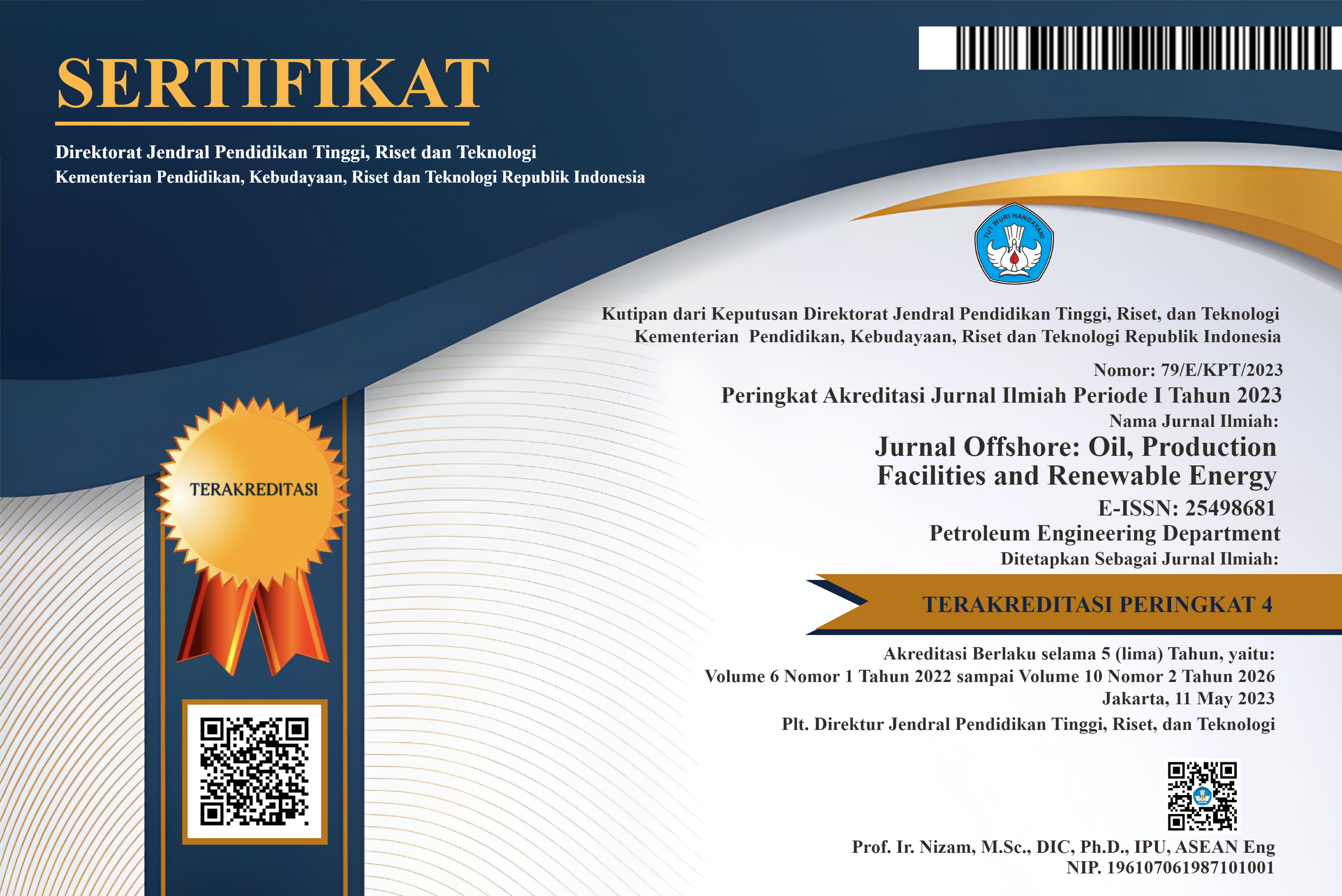Efek Jenis Rod dan Efisiensi Volumetrik pada Kinerja Pompa Angguk
DOI:
https://doi.org/10.30588/jo.v4i2.749Keywords:
SRP, Pump Speed, Stroke Length, OptimizationAbstract
The productivity of the beam pump is influenced by the sucker rod type, material quality, and volumetric efficiency. Therefore, the beam pump should be designed to reach an optimum condition. The type of rod affects ability of the beam pump to lift liquid up from an oil reservoir to the surface as well as the horse power requirement to operate the pump. On the other hand, the productivity of the pump is also influenced by the characteristics of the reservoir rock and fluid such asreservoir productivity, gas liquid ratio, salinity and Hydrogen Sulfide (H2S) which are contained in the reservoir fluid. The purpose of this study is to observe Effect of Rod Type and Volumetric Efficiency on the Performance of a beam pump at X-1 well and production estimation in the future. In this research, several rod types were tested to find their liquid lifting efficiency. Based on result analysis, the highest production as well as liquid lifting efficiency is attained by applying ROD 96/05.The liquid production rate and lifting efficiency of the rod type are 1132 bpd and 15.6. The application of better quality sucker rod material (API grade D) and less corrosive fluid conditions (salt water) will be able to produce fluid with a higher flow rate. Furthermore, the effect of the crank-pitman ratio on the production rate is not large. Lower volumetric efficiency pumps require higher pump speed and horsepower to produce fluid with the same flow rate as high volumetric efficiency pumps. However, pumps with low volumetric efficiency have lower peak loads (PPRL).References
Sabaruddin, M. F. Azmi, I. M., Firdaus, C. E. F., and Shahrazade, M. R., 2019, Optimization and Prediction of Sucker Rod Pump Performance on Well X-1 in Field X in the Future”. Journal of Earth Energy Science, Engineering, and Technology, vol. 2, no. 3, pp. 97-101.
Clarke, F. and Malone, L., 2016. Sucker Rod Pumping in the Eagle Ford Shale Field Study, Society of Petroleum Engineers, SPE-181214-MS.
Dave, M. K. and Mustafa, M. G., 2017. Performance Evaluations of the Different Sucker Rod Artificial Lift Systems, Society of Petroleum Engineers, SPE-189231-MS.
Orji, E., Lissanon, J., and Omole, O., 2016. Sucker Rod Lift System Optimization of an Unconventional Well, Society of Petroleum Engineers, SPE-181242-MS.
Brown, K. E., 1984. The Technology of Artificial Lift Methods, vol. 1. Tulsa, OK: PennWell Publishing Company.
Brown, K. E., 1984. The Technology of Artificial Lift Methods, vol. 4. Tulsa, OK: PennWell Publishing Company.
Beggs, H. D. 2008. Production Optimization Using Nodal Analysis. Oil and Gas Consultants International. Oklahoma.
Eickmeier, J.R. 1968. How to Accurately Predict Future Well Productivities. World Oil, May, 99.
M. A. Klins and J. W. Clark III, 1993. An Improved Method To Predict Future IPR Curves. Society of Petroleum Engineers, SPE-20724-PA.https://doi.org/10.2118/20724-PA.
Ahmed, T., 2019. Reservoir Engineering Handbook, Fifth Edition. Burlington, MA: Gulf Professional Publishing.
Brown, K. E., 1984. The Technology of Artificial Lift Methods, vol. 2A. Tulsa, OK: PennWell Publishing Company.
Takacs, G. and Gajda, M., 2014. The Ultimate Sucker-Rod String Design Procedure, Society of Petroleum Engineers, SPE-170588-MS.
Downloads
Published
How to Cite
Issue
Section
License
Authors retain copyright and grant the Jurnal Offshore right of first publication with the work simultaneously licensed under a Creative Commons Attribution 4.0 International License that allows others to share (copy and redistribute the material in any medium or format) and adapt (remix, transform, and build upon the material) the work for any purpose, even commercially with an acknowledgement of the work's authorship and initial publication in Jurnal Offshore. Authors are able to enter into separate, additional contractual arrangements for the non-exclusive distribution of the journal's published version of the work (e.g., post it to an institutional repository or publish it in a book), with an acknowledgement of its initial publication in Jurnal Offshore. Authors are permitted and encouraged to post their work online (e.g., in institutional repositories or on their website) prior to and during the submission process, as it can lead to productive exchanges, as well as earlier and greater citation of published work (See The Effect of Open Access).















